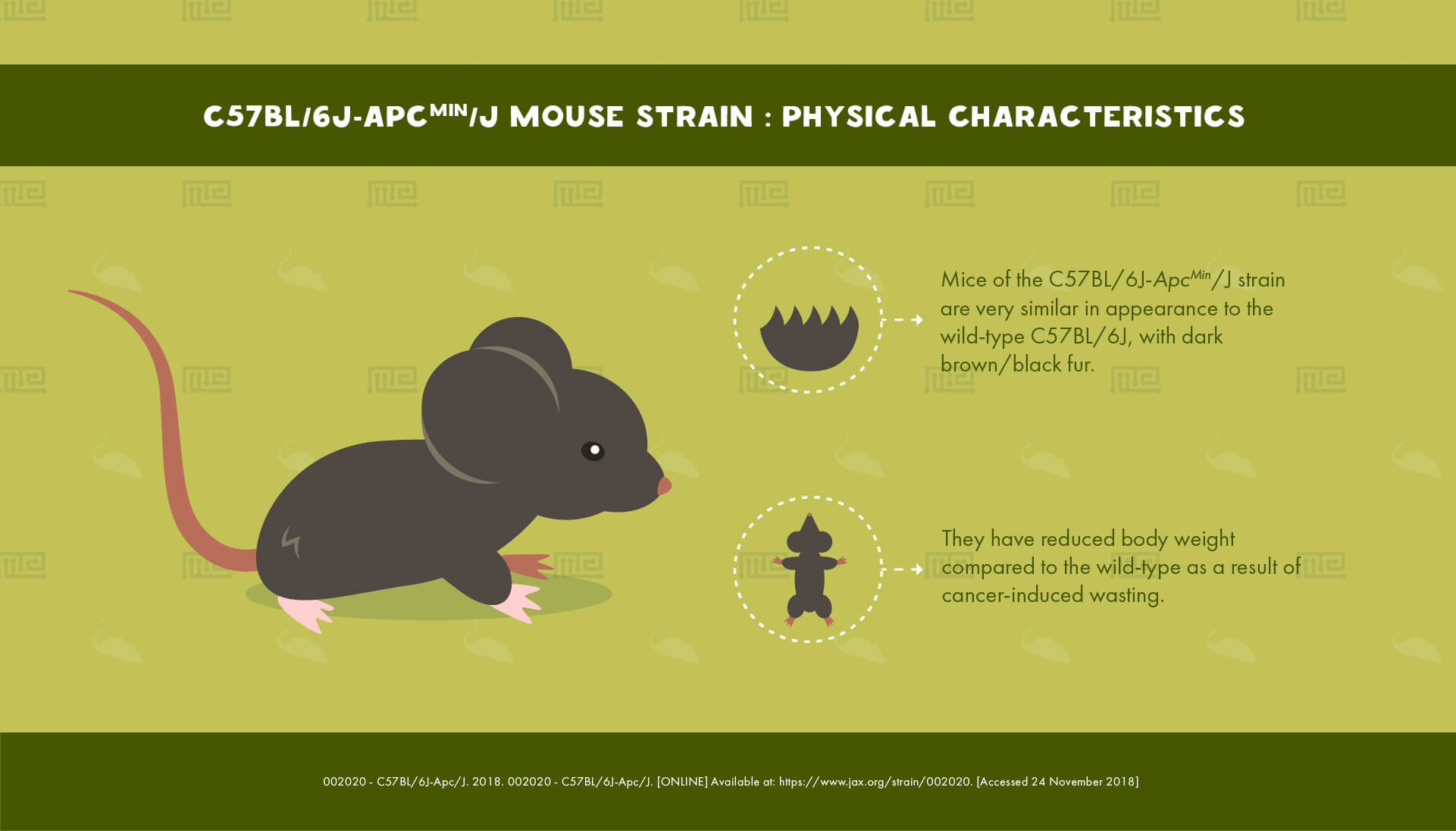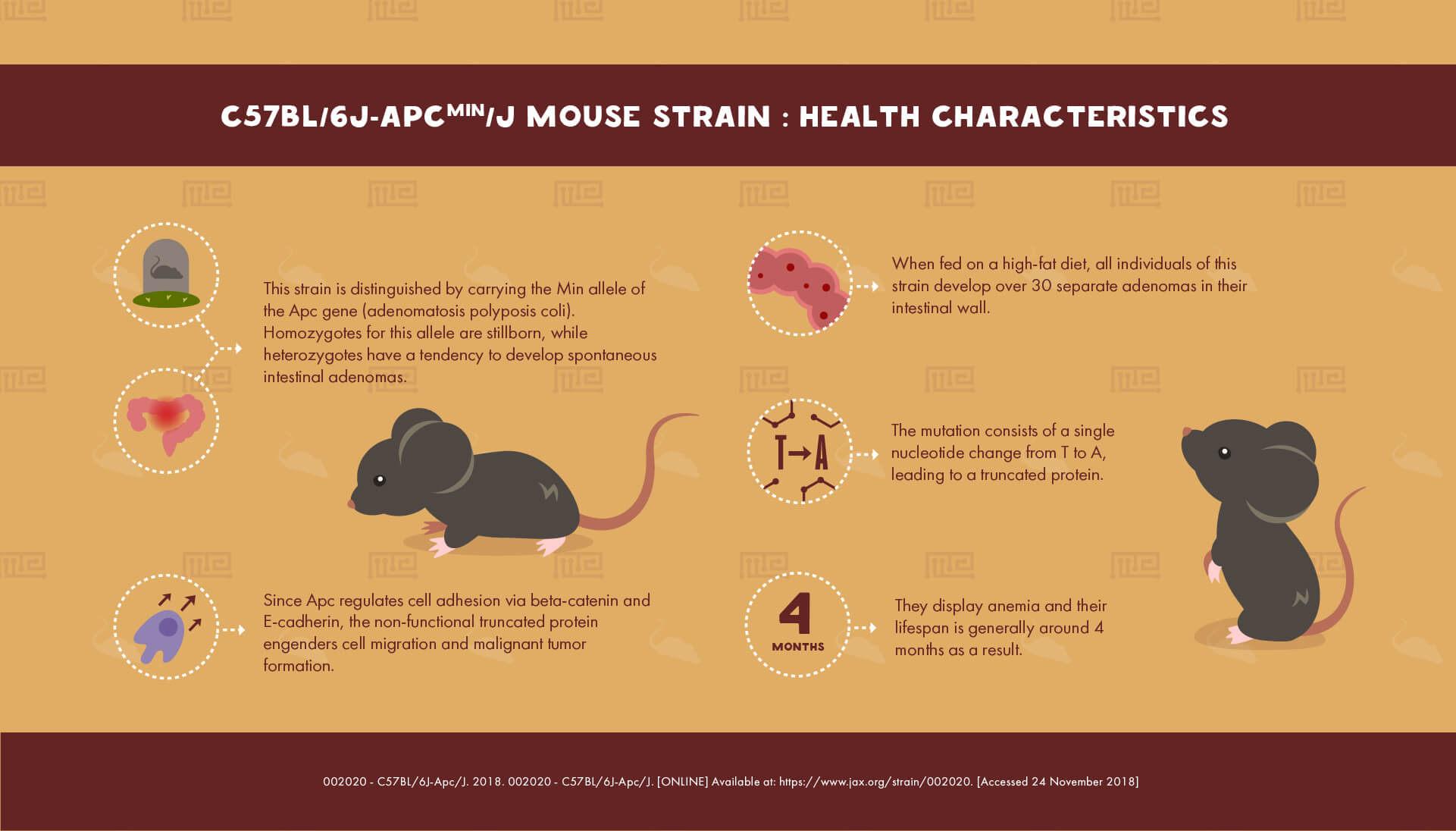Overview
C57BL/6J-ApcMin/J, also known as “Min”, is a strain of mutant mouse model derived from the popular C57BL/6J strain. They are of especial interest for research into intestinal cancers.[1]
History
C57BL/6J-ApcMin/J mice are descended from C57BL/6J, which originated from a cross carried out by Little in 1921. This cross was the origin point for a number of popular strains, including C57BL, C57L, and C58.[2]
N-ethyl-N-nitrosourea (ENU) treatment was used to generate random mutations in a stock of wild-type C57BL/6J mice. The males of this stock were then mated with a female AKR/JxB6 F1, and it was noticed that some of the progeny developed anemia and intestinal cancer. These were the first C57BL/6J-ApcMin/J mice and were sent to the Jackson Laboratory in 1992.[1]
Physical Characteristics
Mice of the C57BL/6J-ApcMin/J strain are very similar in appearance to the wild-type C57BL/6J, with dark brown/black fur. They have reduced body weight compared to the wild-type as a result of cancer-induced wasting.[1]
Behavioral Characteristics & Handling
Breeding performance is poor in this strain and declines with age since cancer and anemia (see below) interfere with pregnancy. It is thus necessary to maintain the strain’s genotype through artificial selection and carefully organized breeding behaviors.[3]
C57BL/6J-ApcMin/J mice exhibit reduced locomotor activity in the open field test, light-dark box, and social interaction test compared to wild-type B6 mice. The mutant mice also show a greatly diminished response to acoustic startle, a behavior that was independent of reduced body weight.
These mice exhibit normal behavior in the forced swim test, suggesting they do not have a depression-like phenotype. However, they do freeze more frequently during fear conditioning, as well as show working memory deficits in an eight arm radial maze test.[4]
No specific information on the handling of this strain could be found. Reports on the handling of the ancestral C57BL/6J strain are mixed, with some sources claiming high docility and others claiming elevated aggression. Researchers requiring a highly docile mouse may want to look to other strains as a precautionary measure.
Health Characteristics
This strain is distinguished by carrying the Min allele of the Apc gene (adenomatosis polyposis coli). Homozygotes for this allele are stillborn, while heterozygotes have a tendency to develop spontaneous intestinal adenomas.
The mutation consists of a single nucleotide change from T to A, leading to a truncated protein. Since Apc regulates cell adhesion via beta-catenin and E-cadherin, the non-functional truncated protein engenders cell migration and malignant tumor formation.
When fed on a high-fat diet, all individuals of this strain develop over 30 separate adenomas in their intestinal wall. They also display anemia. Their lifespan is generally around 4 months as a result.[1]
Major Experimental Uses
Their tendency to spontaneously develop intestinal adenomas means these mice are of most interest to researchers studying colon cancer, as well as other cancers (especially mammary, stomach and small intestine). C57BL/6J-ApcMin/J is an especially good model for mutant Apc induced cancers, as, in this respect, it is very similar to human patients with the same genotype.[1]
References
- 002020 – C57BL/6J-Apc/J. 2018. 002020 – C57BL/6J-Apc/J. [ONLINE] Available at: https://www.jax.org/strain/002020. [Accessed 24 November 2018].
- MGI – Inbred Strains: C57BL. 2018. MGI – Inbred Strains: C57BL. [ONLINE] Available at: http://www.informatics.jax.org/inbred_strains/mouse/docs/C57BL.shtml. [Accessed 24 November 2018].
- The Jackson Laboratory. 2018. The C57BL 6J-Min Mouse. [ONLINE] Available at: https://www.jax.org/news-and-insights/1993/october/the-c57bl-6j-min-mouse. [Accessed 24 November 2018].
- Koshimizu, H., Fukui, Y., Takao, K., Ohira, K., Tanda, K., Nakanishi, K., Toyama, K., Oshima, M., Taketo, M. M., … Miyakawa, T. 2011. Adenomatous polyposis coli heterozygous knockout mice display hypoactivity and age-dependent working memory deficits. Frontiers in behavioral neuroscience, 5, 85.


